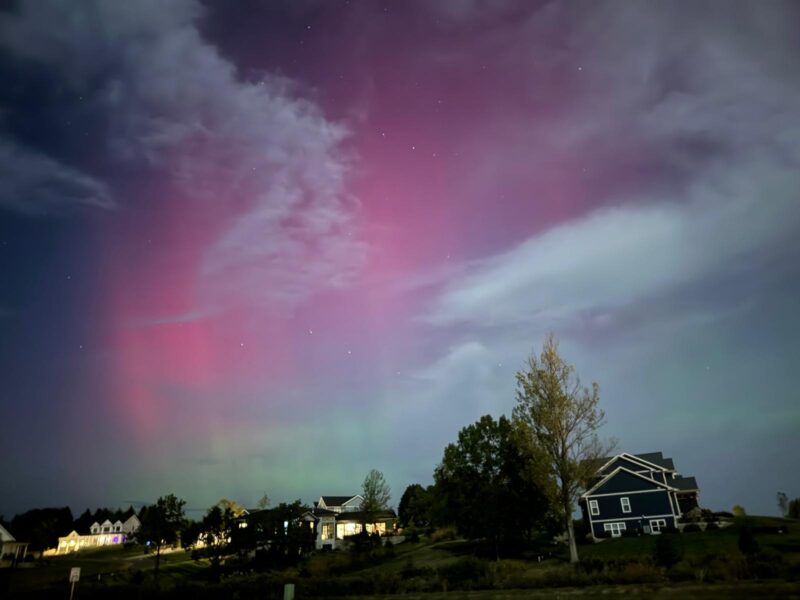Sun News: September 17, 2024 – A Day of Severe Geomagnetic Storms and Stunning Auroras
On September 17, 2024, the Earth experienced a remarkable geomagnetic storm that captivated skywatchers across North America. Initially anticipated to be a G3 (strong) storm, the event escalated to a G4 (severe) storm, resulting in breathtaking auroras visible as far south as northern Texas. This article delves into the causes of this intense solar activity, the stunning auroras it produced, and what we can expect in the coming days.
The Cause of the Storm: Coronal Mass Ejections and Solar Wind
The severe geomagnetic storm was triggered by a series of coronal mass ejections (CMEs) that erupted from the Sun on September 13 and 14. These massive bursts of solar plasma were propelled toward Earth, interacting with high-speed solar wind emanating from a coronal hole. The combination of these solar phenomena created a magnetic disturbance that intensified Earth’s geomagnetic field, leading to the unexpected G4 storm.
What Are Coronal Mass Ejections?
CMEs are significant expulsions of plasma and magnetic field from the Sun’s corona. When directed toward Earth, they can cause geomagnetic storms that disrupt satellite operations, radio communications, and even power grids. The CMEs observed on September 13 and 14 were particularly potent, contributing to the storm’s severity.
Auroras: A Celestial Light Show
Despite the challenges posed by a bright nearly full moon, skywatchers were treated to stunning displays of auroras. Reports flooded in from various locations, including Wisconsin and Wyoming, where EarthSky team members captured the mesmerizing lights. The auroras were visible even in regions not typically known for such phenomena, with sightings reported as far south as northern Texas.
Kelly Kizer Whitt, a member of the EarthSky team, shared her breathtaking photograph of the auroras taken in Wisconsin. The vibrant greens and purples danced across the night sky, a testament to the power of the storm and the beauty of nature.
Did You See the Auroras?
If you were fortunate enough to witness the auroras, EarthSky invites you to share your photos. The community thrives on the shared experience of observing these celestial events, and your contributions help to document the beauty of our universe.
Solar Activity: A Lull Followed by a Surge
In the 24 hours leading up to the storm, solar activity had been relatively low, with only three C flares recorded. The most significant flare, a C9.6 from sunspot region AR3825, occurred just before the storm. While the Earth-facing side of the Sun was quiet, activity was brewing on the far side, where the SOHO spacecraft detected a bright, long-lasting CME that hinted at a significant explosion.
As of September 17, the Sun was home to seven sunspot regions, including newcomers AR3827 and AR3828. The existing regions, particularly AR3824 and AR3825, exhibited beta-gamma magnetic configurations, indicating potential for further solar flares.
What’s Next? Forecasting Solar Activity
Looking ahead, the chances for solar flares remain high. The likelihood of C flares is at 99%, with a 55% chance for M flares and a 15% chance for X flares. While no new Earth-directed CMEs were observed at the time of writing, the ongoing geomagnetic activity suggests that minor-to-moderate storming could continue throughout the day.
As of 11 UTC on September 17, a G1 (minor) geomagnetic storm was still in effect, with expectations of returning to quiet-to-unsettled levels in the following days.
Conclusion: A Day to Remember
September 17, 2024, will be remembered as a day of extraordinary solar activity and stunning natural beauty. The severe geomagnetic storm not only provided a spectacular light show for many but also served as a reminder of the dynamic and ever-changing nature of our Sun. As we continue to monitor solar activity, we can only wonder what other celestial wonders await us in the days to come.
For those who enjoy capturing the beauty of the cosmos, EarthSky encourages you to submit your photos of the Sun and auroras. Together, we can celebrate the wonders of our universe and share in the excitement of astronomical events.
